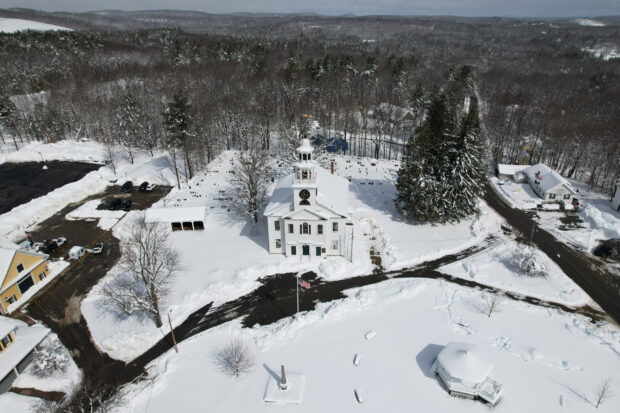
Snow from a recent nor’easter storm covers the town common and the First Parish Church in Ashby, Massachusetts, U.S., March 15, 2023. (REUTERS)
NEWPORT BEACH, Calif. – An atmospheric river dumped more torrential rain on California on Wednesday, forcing evacuations, power outages and road closures, as the remnants of a powerful Nor’easter blizzard buried much of upstate New York and New England under snow.
While the U.S. Northeast is conditioned for snowstorms each winter, the West Coast is getting pounded by an usually wet season following two decades of drought, creating havoc on the roads and endangering blufftop homes along the coast in southern California’s Orange County.
The National Weather Service (NWS) predicted ongoing winter storms and atmospheric river events on the West Coast through March 21-23, warning of potential flooding and mudslides from heavy rain, melting snowpack, saturated soils and swollen streams.
“We are not out of the woods by any stretch of the imagination,” said Brian Ferguson, spokesman for the California Office of Emergency Services.
A spate of atmospheric rivers – the term used by meteorologists to describe airborne currents of dense, tropical moisture from the Pacific – lashed California in rapid succession from late December through mid-January, leading to the deaths of at least 20 people.
Another churned through the state this week, causing at least four fatalities, Ferguson said.
The storm knocked out power to 156,000 homes and businesses in California, PowerOutage.US said.
In Newport Beach, a wealthy Orange County enclave, one home with spectacular ocean views hung in the balance as the blufftop beneath it collapsed. Pacific Coast Highway was closed at several points elsewhere along the Orange County coast, where residents in other blufftop homes were evacuated.
But most of the threat loomed over northern California and the agricultural Central Valley.
The Sacramento River, the longest in the state, was reaching flood stage just below Shasta Dam, the state’s largest reservoir, the National Weather Service said, issuing flood warnings to several towns along the river.
In Tulare County, a farm region in the San Joaquin Valley, the Success Lake reservoir reached its capacity, forcing officials to release water through the Schafer Dam spillway and ordering evacuations downstream.
Tulare County sheriff’s deputies will be going door-to-door, urging people to “stay clear and out of the river areas and to avoid getting near the waterways,” officials said.
Monterey County reissued an evacuation order for a 25-mile (40-kilometer) stretch along the Salinas River and Highway 101, most of it low-lying farmland. The county just south of San Francisco closed roads along the coast and inland.
California Governor Gavin Newsom was due to visit Monterey County on Wednesday.
SNOW IN THE EAST
In the Northeast, a late-winter blizzard dumped about 2 feet (60 centimeters) of snow in the Berkshire mountains of western Massachusetts and northwestern Connecticut, and a foot or more in parts of New York’s Hudson Valley. About 129,000 customers lacked power in New York and New England, PowerOutage.us said.
Across Massachusetts the accumulations left by the Nor’easter – a type of storm that affects the U.S. East Coast and is named after the direction of the wind – varied greatly. In Colrain in the northwestern part of the state near the Vermont border, 3 feet (91 cm) of snow was on the ground, while Boston’s suburbs had about an inch.
Colrain town administrator Kevin Fox said he had no electricity or cell service at his home and had gone to his office, even though town hall was closed, so that he could call his mother.
“I have no idea who has power or who doesn’t,” Fox said.
Colrain, with 1,700 residents, has only five snow plows and Fox was uncertain how long it would take to dig out.
In western Vermont around Burlington, about 200 miles (320 km) northwest of Boston, 24 inches (60 cm) of snow piled up in some locations since early Tuesday, according to NWS meteorologist Marvin Boyd, who saw six inches at his house fall in two hours.
But he said heavy snow was typical in Vermont. He had to shovel out and drive his children to school Wednesday morning before work. “We’re used to this,” Boyd said.